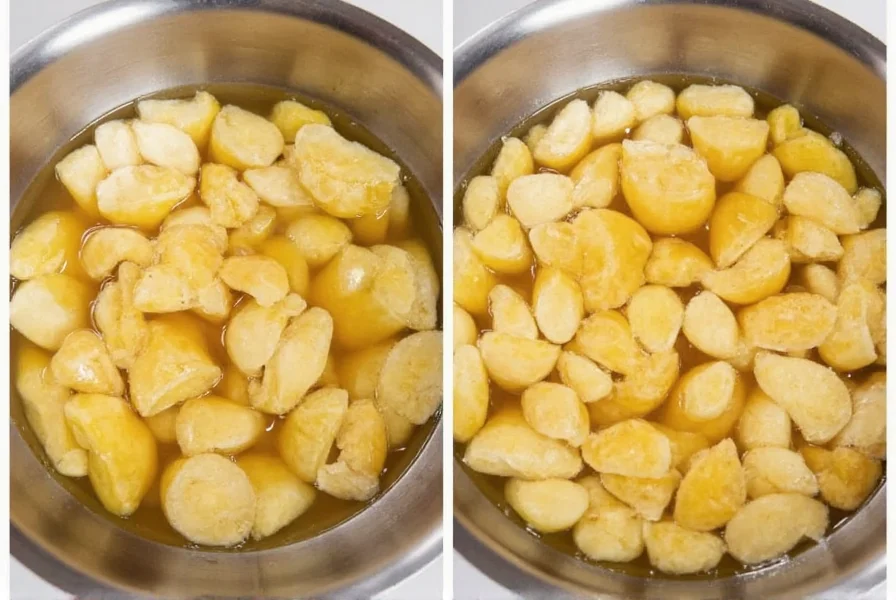Making homemade candied ginger is simpler than most people realize and yields a superior product to store-bought versions. This traditional preservation method transforms pungent fresh ginger into a sweet, chewy delicacy with a spicy kick. The process requires just three basic ingredients and minimal equipment, yet produces a versatile ingredient that can elevate desserts, teas, and even savory dishes.
Unlike commercial varieties that often contain preservatives and artificial flavors, homemade candied ginger lets you control the sweetness level and ensures maximum freshness. The natural gingerol compounds remain active, preserving many of ginger's celebrated digestive benefits while creating a shelf-stable treat.
Essential Ingredients for Perfect Candied Ginger
The beauty of this recipe lies in its simplicity. You'll need only three core ingredients, though optional additions can create interesting variations:
| Ingredient | Amount | Why It Matters |
|---|---|---|
| Fresh ginger root | 1 pound (450g) | Choose firm, smooth rhizomes with taut skin for maximum flavor and texture |
| Granulated sugar | 2 cups (400g) | Creates the syrup base and final coating; caster sugar dissolves more readily |
| Water | 2 cups (480ml) | Forms the simple syrup; filtered water prevents mineral interference |
| Lemon juice (optional) | 1 tablespoon | Prevents crystallization and adds brightness to balance sweetness |
Equipment Checklist
While specialized equipment isn't necessary, these tools ensure consistent results:
- Sharp vegetable peeler or spoon for ginger skin removal
- Sharp chef's knife or mandoline slicer
- Medium heavy-bottomed saucepan (3-4 quart capacity)
- Fine mesh strainer
- Baking sheets lined with parchment paper
- Cooling rack
- Airtight storage containers

Step-by-Step Preparation Guide
Follow these detailed instructions for foolproof candied ginger every time. The key to success lies in proper simmering time and sugar concentration.
Preparation Phase (15 minutes)
- Peel ginger using a spoon's edge (more efficient than a peeler for knobby roots)
- Cut into uniform 1/8-inch thick slices for even cooking
- Weigh ginger to ensure proper sugar-to-ginger ratio
- Place slices in saucepan and cover with cold water
- Bring to boil, then drain to remove bitterness
Cooking Process (45 minutes active time)
- Create simple syrup: Combine sugar and water in clean saucepan, heat until sugar dissolves completely
- Add ginger slices and optional lemon juice to syrup
- Simmer uncovered at low temperature (gentle bubbles only) for 30-45 minutes
- Test for doneness: Slices should be translucent with no raw center
- Remove from heat and let cool in syrup for 2 hours (enhances flavor absorption)
Finishing and Drying (24 hours total)
- Drain ginger slices, reserving syrup for other uses
- Toss slices in additional sugar (about 1/2 cup)
- Arrange on parchment-lined baking sheets with space between pieces
- Air-dry at room temperature for 8-12 hours or use dehydrator at 135°F (57°C) for 4-6 hours
- Store in airtight container with parchment between layers
Pro Tips for Perfect Results
Professional candymakers and experienced home cooks recommend these techniques for optimal homemade candied ginger:
- Texture control: For softer candy, simmer 30 minutes; for firmer texture, extend to 45 minutes
- Sugar alternatives: Replace up to 25% of granulated sugar with glucose syrup to prevent crystallization
- Flavor variations: Add citrus zest, cinnamon sticks, or vanilla bean during simmering
- Double-coating: For extra sweetness, dip dried ginger in melted dark chocolate
- Syrup reuse: Reserved syrup makes excellent ginger simple syrup for cocktails or ginger tea
Storage Guidelines and Shelf Life
Proper storage ensures your homemade candied ginger maintains quality and safety:
- Store in airtight container at room temperature for up to 3 months
- Place parchment paper between layers to prevent sticking
- Refrigeration extends shelf life to 6 months but may cause slight texture changes
- Freeze for up to 1 year in vacuum-sealed bags
- If surface becomes sticky, toss with additional sugar
- Discard if mold appears or aroma changes significantly

Creative Uses Beyond Snacking
While delicious on its own, homemade candied ginger elevates numerous recipes:
- Chop finely and add to cookie or scone dough
- Infuse cream for ginger-flavored ice cream or panna cotta
- Create a spicy-sweet glaze for roasted carrots or sweet potatoes
- Add to fruit salads for a flavor contrast
- Steep in hot water for soothing ginger tea
- Finely dice and mix into chocolate ganache
- Pair with blue cheese on cheese boards
Troubleshooting Common Issues
Even experienced cooks encounter challenges when making candied ginger. Here's how to solve frequent problems:
- Crystallized syrup: Caused by undissolved sugar or temperature fluctuations. Solution: Add 1 tablespoon lemon juice next time and maintain consistent low heat.
- Too spicy: Ginger wasn't boiled to remove bitterness. Solution: Always blanch ginger in boiling water before syrup cooking.
- Too hard: Overcooked or insufficient syrup absorption. Solution: Reduce simmer time and allow longer cooling in syrup.
- Too soft: Incomplete drying. Solution: Extend air-drying time or use dehydrator at slightly higher temperature.
- Mold growth: Improper drying or storage. Solution: Ensure complete dryness before storage and use airtight containers.
Popular Variations to Explore
Once you've mastered the basic technique, experiment with these adaptations:
- Crystallized ginger: Skip the final sugar coating and dry completely for a less sweet version
- Spiced ginger candy: Add star anise, cloves, or cardamom to the syrup
- Tropical twist: Replace water with coconut water in the syrup
- Low-sugar option: Use erythritol or monk fruit sweetener (results may vary in texture)
- Alcohol-infused: Soak finished ginger in bourbon or rum for 24 hours











 浙公网安备
33010002000092号
浙公网安备
33010002000092号 浙B2-20120091-4
浙B2-20120091-4